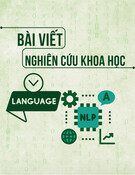
TẠP CHÍ KHOA HỌC - SỐ 85/THÁNG 6 (2024) 95
APPLYING EXTENSIVE READING
TO IMPROVE STUDENTS’ READING SKILLS
FOR SECOND YEAR ENGLISH MAJORS IN
HANOI METROPOLITAN UNIVERSITY
Dương Thị Huyền
Trường Đại học Thủ đô H Nội
Abstract: The present study aims to elucidate whether extensive reading enhances
students’ reading skills of the second year English majors in Hanoi Metropolitan
University. An extensive reading program lasted for ten weeks. The design of the study
was experimental research which used quantitative approach. The objective of this
research was 62 English major sophomores in HNMU in the academic year 2023-2024.
They were assigned to two groups: 31 students in the control group (NNA.D2022.N04)
and 31 students in the experimental group (NNA.D2022.N05). The experimental group
was applied extensive reading outside reading class during ten weeks, while the control
group was given no extensive reading. Pre- and post-test procedure was used to measure
the impact of the extensive reading on the students' achievement in term of their reading
skills. The findings of this study revealed that there are significant differences in students'
reading skills in the extensive reading class, in favor of the experimental group. It can be
concluded that an extensive reading programme is indeed feasible. Therefore, it is
recommended that extensive reading be integrated into the English reading courses.
Keywords: Extensive reading, English majors, Hanoi Metropolitan Univerity, reading
skills, student.
Nhận bài ngày 10.03.2024; gửi phản biện, chỉnh sửa và duyệt đăng ngày 30.06.2024
Liên hệ tác giả: Dương Thị Huyền; Email: dthuyen@daihocthudo.edu.vn
1. INTRODUCTION
Reading is one of the prominent skills that should be mastered by learners since it
contributes a lot of benefits for them. By reading they can expand their knowledge and
open their mind toward knowledge and information around the world. Moreover, reading
can also boost such other language skills as listening, speaking and writing at the same
time.
Reading is an active process and the readers need to use reading skills to make them
attain good reading comprehension. Anderson (1999) said “With strengthened reading
skills, ESL/EFL reader will make greater progress and attain greater development” [1, p.1].
Therefore, it can’t be denied that reading skills support significantly to readers’ reading
comprehension. The better the reader uses reading skills, the better he/ she gains reading
comprehension. Therefore, how to teach reading skills well and effectively has been the
concern of the teachers.

96 TRƯỜNG ĐẠI HỌC THỦ ĐÔ HÀ NỘI
In students’ academic lives, reading comprehension is the basis for understanding all
the academic content. The importance of reading comprehension increases significantly in
all academic subjects as students go ahead through grades. In particular, students need
reading comprehension skills to successfully accomplish the educational expectations at
school and in the classroom. For example, students are expected to understand what they
are reading from multiple sources in order to research topics in different academic areas.
Also, being able to understand what they are reading allows students to quickly locate
pertinent information, exclude non-relevant information to the present topic, and identify
the important information to focus on. Academic success also requires students to be able to
understand, analyze, and apply information they gathered through reading. Also, students
need reading comprehension skills to be able to understand and perform their academic
assignments. In other words, without having reading comprehension skills, students cannot
accomplish all of that work [2]. Therefore, reading comprehension skills are so important
that students should be taught in their English reading classes.
There are two kinds of teaching reading, they are extensive reading and intensive
reading. Extensive reading covers large area, while intensive reading covers narrower area.
According to Graham Stanley in Fiprinita (2013), extensive reading involves students
reading long texts or large quantities for general understanding, with the intention of
enjoying the texts. It means that students have freedom to choose their own topic which
they are interested. In this case, the students also have to find supported articles related to
the topic in order to give them background knowledge, so that they know more about the
topic they have chosen. However, intensive reading does not allow the students to find a
topic they like. The topic is given by the teacher, and the topic which is chosen by the
teacher is usually short and easy to understand. Both intensive and extensive reading are
really significant to prepare students for the tasks and texts they encounter in universities.
Intensive reading with a focus on skills/strategies instruction has been seen to provide
positive effects on second language reading. At the same time, students need to practise
extensive reading in order to apply intensively acquired skills/strategies over the larger
texts and multiple reading sources that are required in all academic course work. In fact,
intensive reading is more popular in English reading classes than extensive reading.
Teachers often give students some English reading passages and ask students to do some
given tasks after reading the passages. While, there is a little chance for extensive reading
because extensive reading takes much time and effort form both teachers and students.
As for Ng, Renandya & Chong (2019), there are many different terms for extensive
reading, including pleasure reading, self-selected reading, free voluntary reading, and wide
reading [3]. Extensive reading is a technique in teaching reading which is defined as a
situation where students read a lot of materials at their level in a new language; they read
for general, overall meaning, and information at once with enjoyment [4]. Furthermore,
Richards and Schmidt (2002) state that extensive reading is intended to develop good
reading habits, build up knowledge of vocabulary and structure and encourage a liking for
reading [5]. Besides improving students’ knowledge, McLean et al (2017) also said that
extensive reading is an effective and efficient method to improve students’ reading rates
[6]. According to Nation (2005), during extensive reading, students should be interested in
what they are reading and should be reading with their attention on the meaning of the text
rather than on learning the language features of the text. In many cases, students tend to
read what they like [7]. Thus, it is very important to always motivate them to read more.
Extensive reading is projected to expose students to an input-rich and enjoyable
environment, with the intention that their language knowledge will improve and their

TẠP CHÍ KHOA HỌC - SỐ 85/THÁNG 6 (2024) 97
enthusiasm to learn will develop naturally (Hedge, 1985, cited in Sheu, 2003) [8].
Furthermore, Harmer (2002) asserts that extensive reading is an activity that can be applied
by teachers to encourage students to choose what they read and to do so for pleasure and
general language improvement [9, p.210]. Therefore, extensive reading activity should be
supported by various reading materials for enjoyment, enrich their knowledge, and
language development.
For the importance of extensive reading, one of direct implication for teaching reading
is providing the students with an opportunity to read not only in the classroom but also
outside of the classroom. It is also necessary that students are provided with activities or
tasks to read outside classroom as a means of practice to develop reading abilities. Students
should also be encouraged to read as often as possible. Extensive reading can be conducted
in the classroom generally accompanied to an English course (Davis, 1995) or as an after-
school activity (Day & Bamford, 1998) [10].
Claims have been made that extensive reading invigorates reading comprehension (Al-
Homoud & Schmitt, 2009; Davis, 1995 [11]), reading rate (Mason & Krashen, 1997 [12])
and positive attitudes toward reading (Dupuy, Tse, & Cook, 1996 [13]) because of the self-
selection of reading material and minimal accountability in comparison with traditional
assessment (Davis, 1995 [14]; Mason & Krashen, 1997 [12]), and the ultimate aim of ER
(like other reading approaches) is to develop grammar knowledge, vocabulary growth, and
reading comprehension and speed of language learners (Grabe, 2009; Nakanishi, 2015
[15]).
Also, Nation & Mingtzu (1999) explained that extensive readers help learners with
“gaining skills and fluency in reading, establishing previously learned vocabulary and
grammar, learning new vocabulary and grammar” (p.356). Besides, the out-of-class
pleasure reading has the effect of improving students’ reading skills, their confidence, and
self-identification as readers (Kitao, Yamamto, Kitao and Shimatani, 1990; Stoller, 1994
[16]).
In fact, numerous studies have reported the impact of extensive reading on learners at
different age levels and in different contexts. The figure is drawn by some reserchers as
followed.
Figure 1: The benefits of extensive reading

98 TRƯỜNG ĐẠI HỌC THỦ ĐÔ HÀ NỘI
It can’t be denied that ER brings a lot of benefits to language learners. Extensive
reading (ER) has long been advocated and perceived as an effective and stimulating
instructional approach to enhance learners‘ language proficiency. It has been highly valued
by numerous scholars and researchers in the language learning field. Nuttall (1982)
concludes by citing what other researchers often say when referring to extensive reading,
“The best way to improve one‘s knowledge of a foreign language is to go and live among
its speakers. The next best way is to read extensively in it” [17, p.168]. Extensive reading
will help students to process words faster and they will be better able to read intensively.
They will also learn from reading. As students read they are constantly practising the
"guessing from context" skill, so vital for work with the difficult texts that appear on tests.
Extensive reading is considered to be beneficial to help students acquire a language,
especially in university level.
2. CONTENT
2.1. Review of Related Studies on Extensive Reading
Several studies were conducted by many researchers related to extensive reading. The
first study is carried out by Levy (2016) entitled Extensive Reading in English as a Foreign
Language/English as a Second Language Contexts [18]. This article examined the role of
extensive reading in the foreign language and second language context. It covered the
usefulness of extensive reading in language acquisition, the effectiveness of extensive
reading in language acquisition in specific contexts, and sustained silent reading.
The second study is conducted by Liu and Zhang (2018) with the tittle The Effects of
Extensive Reading on English Vocabulary Learning: A Meta-analysis. This paper presented
the existence of extensive reading to upgrade students’ language proficiency, including
grammar awareness, vocabulary mastery and reading proficiency [19]. This study collected
the data from 21 empirical studies. The results showed that: (1) extensive reading has a
significant effect on English vocabulary learning; (2) one semester (less than three months)
is the most appropriate length of extensive reading instruction for vocabulary learning; (3)
Graded Readers, comprehension questions and vocabulary exercise play significant roles as
reading materials and education methods in promoting the vocabulary learning of EFL
learners.
The third study is conducted by Ruzin (2019) entitled Implementing Extensive Reading
to Boost Students’ Reading Ability [20]. The purpose is to review some theories and
studies on the use of extensive reading in improving students’ reading ability. This paper
also discussed students’ difficulties in reading, reading materials, extensive reading
definition, and the implementation of extensive reading.
Similarly, Kreft and Viebrock (2014) who point out the affective benefits of extensive
reading programmes state that extensive reading leads to a significant increase in the
amount of foreign or second language materials read by learners through affecting learners’
enjoyment of reading [21]. Besides, the autonomy and freedom of learners to choose the
reading material at their interests and proficiency levels is considered as a reward to them
(Day & Bamford, 1998; Bamford & Day, 2004). Kirchhoff (2013) acknowledges extensive
reading as “a teaching practice that is likely to positively influence L2 students’ reading
motivation” [21, p.196]. According to Lee, Schallert and Kim (2015), extensive reading
“engenders positive attitudes because reading depends on positive attitudes to become a
frequent activity in a language learner’s life”. Therefore, extensive reading creates positive
effects on attitude, and L2 reading motivation of learners (Elley, 1991 [23]; Mason &

TẠP CHÍ KHOA HỌC - SỐ 85/THÁNG 6 (2024) 99
Krashen, 1997 [12]; Mikami, 2017 [24]; Takase, 2007 [25]) and it “entails learners reading
as much as possible” (Al-Homoud & Schmitt, 2009, [21, p.383].
2.2. Methodology
The main purpose of the current study was to find a practical way for improving
learners’ reading skills in English language. This study is set out to investigate the
effectiveness of extensive reading in developing the reading skills of the second- year
English majors in HNMU involved in the treatment of the study. Therefore, the current
study addressed the following research question:
"Whether extensive reading boosts the English reading comprehension skills for the
second year English major students in HNMU or not?".
2.2.1. The Study Sample
The study was carried out in the context of two English classes in the Foreign
Language Faculty of the Hanoi Metropolitan University (HNMU). The sample consisted of
sixty-two students from two classes selected at random from second year major students of
English in HNMU in the academic year 2023-2024. One class was randomly assigned to be
the experimental group (NNA.D2022.N05). This class consisted of thirty-one students and
they received the treatment based on extensive reading activities designed and taught by the
researcher during ten weeks in the first term. The other class was assigned to be the control
group (NNA.D2022.N04). It consisted of thirty-one students and this group had the regular
English reading lessons with no treatment. Here are the results of Pre-test.
Data
Class
N
M
S.D.
Level of Significance
Control class
31
16.72
1.61
Not significant
Experimental class
31
16.50
1.62
Table 1: Results of Pre-test
Table 1 indicates that the difference between the mean scores of the students in the two
groups was only 0.01. This means that there was no statistically significant difference
between the mean scores of the students in the experimental and control groups. Therefore,
it can be said that the groups were almost at the same level before the experiment.
2.2.2 The Design of the Study
In this study, the experimental group was exposed to the extensive reaading to help
enhance their reading comprehension skills. The experimental group and the control group
were subjected to a pre-post reading comprehension test, prepared by the researcher to
validate the effectiveness of the experimental activities. The pre-test was given to both
groups to make sure of the equivalence of the level of the students in the two groups.
2.2.3. The Instrument
The researcher used a reading test with three passages. All questions are in the form of
multiple choice question (MCQ). The reading test is considered as a tool for testing in order
to know students’ reading comprehension skill. There are 60 items with four alternative
options that are A, B, C, and D in the test. The specific tests of pre-test and post-test were
as follows:

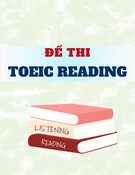

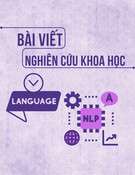


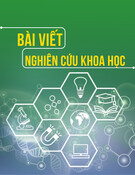


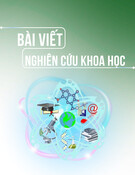

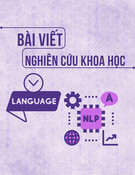
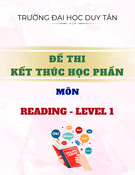
![Đề cương môn Tiếng Anh 1 [Chuẩn Nhất/Mới Nhất]](https://cdn.tailieu.vn/images/document/thumbnail/2025/20251130/cubabep141@gmail.com/135x160/51711764555685.jpg)


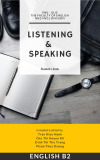





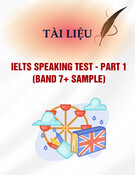
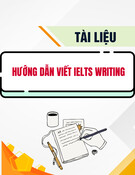
![Mẫu thư Tiếng Anh: Tài liệu [Mô tả chi tiết hơn về loại tài liệu hoặc mục đích sử dụng]](https://cdn.tailieu.vn/images/document/thumbnail/2025/20250814/vinhsannguyenphuc@gmail.com/135x160/71321755225259.jpg)
